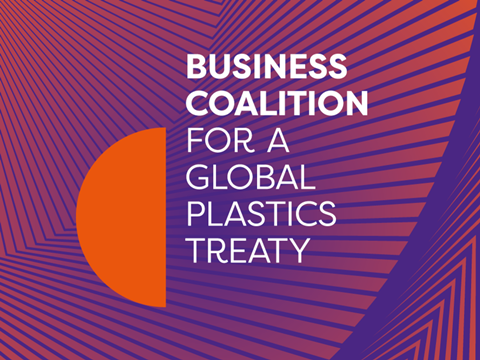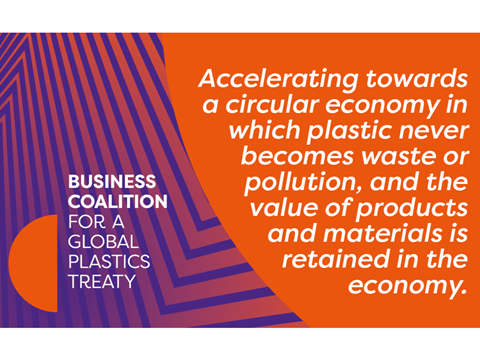
Following the announcement of the Ellen MacArthur Foundation and the World Wildlife Fund’s partnership to create a business coalition in support of a global plastics treaty, we spoke to Carsten Wachholz, senior policy manager at the Foundation, about the aims of the coalition and its goals for the future.
What was the initial drive behind creating a business coalition for the global plastics treaty?
Our starting point was the resolution being adopted at UNEA.
Until we launched our statement, ahead of UNEA 5.2, the only industry that actively engaged in the multilateral discussions was the chemicals industry. And their approach was focused almost exclusively on waste management.
That would be only half of the solution and it doesn’t change business as usual enough to lead to a system change to solve the plastics pollution crisis.
We also looked at the rapid growth projections for plastic production and it would be impossible for governments to catch up with building the infrastructure and systems needed to collect the growing amount of plastics waste generated.
We wanted to build the first business coalition that has adopted the comprehensive circular economy approach to plastics, including a strong emphasis on reduction, and an intent to rethink what was put on the market in the first place. By mentioning the need for both upstream and downstream policy measures, we are setting ourselves apart from other business groups, who still equate circular economy with recycling only.
That was the original intent, to bring different players from all parts of the value chain together, but also have the financial sector onboard and NGOs supportive of the overall ambition - what a system change approach would need and what the treaty would require to support this.
Could you talk me through some of the key points of the business statement, on the vision for a global treaty?
Our vision is a circular economy in which plastic never becomes waste or pollution, and the value of products and materials is retained in the economy.
Looking at three major areas, the first one is the reduction of plastic production use – through a circular economy approach – and focusing on problematic plastics that have a high leakage rate, are short lived and become waste very quickly, and/or are made from fossil fuels.
The second level is that we need to circulate all the plastics we still need and we cannot eliminate – keeping them in the economy and out of the environment, but also maintaining the value embedded in plastic materials and products.
And finally, we need to acknowledge that this is a long trajectory, and there will always be leakage to some extent, so looking at where we have to prevent or mediate very hard to abate sources and pathways of both macro and microplastics.
Even if we are creating perfect loops for some plastics, there will always be something else, where we need to safeguard that we are not harming communities, we’re not harming nature, we’re not harming health.
There are different dimensions we need to look at; there may be plastics that hinder progress to a circular economy; there may be plastics – or plastic additives – that pose critical health risks; or have high risk of ending up in nature.
We need to look at regular financial incentives in a positive way to scale circular economy solutions, including reuse - by stimulating the necessary innovation, investments, consumer choices, and design mechanisms to ensure dedicated, ongoing sufficient funding for after use, collection and treatment of plastics, for example extended producer responsibility schemes.
There is a social dimension to all of this, so we need to take a careful look at provisions to protect and respect livelihoods, labour, human rights of people involved in the value chain, especially those who are workers in informal cooperative settings. There’s a key role to play on provisions to improve transparency and accountability, both for governments and businesses, because we currently lack consistent data and harmonised disclosures that would help us share relevant information across the value chain and inform the financial sector to support the right solutions.

Could you talk a bit more about some previous milestones for the Ellen MacArthur Foundation and WWF, working towards that realisation of a global treaty?
Our collaboration started in summer 2020 with the Boston Consulting Group, analysing for the first time the business case for a global plastics treaty. It looked at the limitations of existing voluntary initiatives, lack of consistent data and metrics, insufficient interventions, more upstream in the plastic value chain, and missing waste management capabilities in many countries.
Based on the recommendations of that report, we lined up in October 2020 around 50 businesses from our respective networks, to support a call for a global treaty, which would aim at harmonising policy efforts to tackle plastic pollution, enhance investment planning, stimulate innovation and coordinate infrastructure development.
Then things changed, most notably Covid! We had a postponement of the UNEA meeting in Nairobi so it took place in February 2022, we had more time in 2021 to engage with various governments on what kind of global agreement would be needed and we secured additional support from the financial sector for the treaty.
Their concerns related to lack of transparency, the extent companies contribute to the problem or provide solutions to it, the risk of stranded assets when they’re investing in the plastic value chain, negative publicity but also diverging policy approaches.
Then we brought these two groups together. Ahead of UNEA 5.2, we joint campaigned together with WWF in leveraging a joint statement of over 1060 businesses and financial institutions, and we outlined a few high-level principles we wanted to see reflected in the negotiation mandate adopted by the government.
We got a comprehensive mandate agreed for starting negotiations. Looking at both upstream and downstream, creating a level playing field and avoiding a patchwork of disconnected solutions to make a circular economy approach work in practice and in scale, and provide robust governments to ensure that companies participate in complying with the treaty and hopefully base their definition on common definitions and harmonised standards.
Why do you think it’s so important for businesses and NGOs to come together on this, and what are your thoughts on how you can encourage more of them to take part in the coalition?
It’s really important to emphasise we don’t only have individual companies in the business coalition, we also have a couple of other NGOs and supporting business groups.
By creating more alignment around our common ambitions, we believe we can amplify our key messages to the negotiators and have a greater chance of seeing that they will be taken on board, or incorporated in the final agreement.
We have also secured endorsers in countries like Brazil, Singapore, Mexico, Colombia, South Africa – it is explicitly stated as one of the objectives of our coalition to work towards more diverse representation with members and supporting organisations coming from different geographies, different sizes and sectors, including the financial institutions.
It’s not necessarily a question of quantity of members, but rather having an inclusive group that supports a common vision.
Whilst you’ve been creating the coalition, what have you found to be the main challenges that you’ve come across?
So far we’ve done surprisingly well. Due to the time pressure, we started that journey end of June and we brought this line up of endorsing organisations together within two months. What really matters for us is that we align behind a clear and collective voice, as businesses and NGOs, to be able to play a positive role in the treaty negotiations – and this should be perceived independently of what individual companies are doing.
At the same time, we’ll continue calling on companies to accelerate their efforts towards a circular economy for plastics on a voluntary basis, and improve transparency on progress that they make, or not, so that we can hold them accountable, and this is what we are doing, for example, through our work with UNEP on the global commitment and the world progress reports.

Having a global treaty would bring a lot of people together. Depending on geographically where people are, there can be different legislation, there can be different restrictions so it might be good to have that unified vision to be working towards.
On the other hand this is one of the big roadblocks - if you want to achieve an ambitious global plastics treaty, you need to look at where people stand today and how you can help them advance, and also to some extent tailor the solution when they’re implementing the provisions of the treaty.
The complexity and the broad scope of the mandate we are all happy with, because it mirrors the magnitude of the problem at hand, but it also points out we are no longer talking about just a few problematic single use plastic items, or only about packaging – it goes far beyond that, we may need to have more sector specific approaches under the treaty and there is a tight timeline to agree on a new international policy framework, though the latter can also be helpful to find compromises.
Then again, where we can help tackling some of the stumbling blocks is that we don’t confront the negotiators with a multitude of individual companies’ positions that may not always be consistent.
We would be more powerful if we focus on key lessons learned from the implementation of circular solutions that already work in practice today, that need to be scaled effectively, collectively, and we intend to be frank and open to select carefully the examples where businesses in different sectors, different parts of the value chain and geographies failed to make sufficient progress, and provide insights into the reason why. We need to ask ourselves: where’s the policy support crucial and needed, to overcome these barriers?
In terms of working towards a circular economy, what are some of the main outcomes that you would like to see on a local and national level?
It’s crucial that these national initiatives need to be aligned with our overall vision. But in our view, the company must set comprehensive and coordinated measures to accelerate transition to a circular economy for plastics globally, and at the same time include supporting mechanism tools for its effective implementation. And these tools need to allow for the adaptation of solutions to the local conditions.
Many different regions of the world face different starting points and challenges when tackling plastic pollution, however, because of the international trade of plastics, packaging and waste, they need to agree on common definitions, metrics and to some extent common standards.
We would like to see the treaty accelerating progress in the reduction, elimination or at least significant reduction of small format flexible plastic packaging, the ‘Sachet’ economy – we have seen far less progress than we wanted to see on scaling reuse solutions, and in our view as a foundation, we would want to see those solutions to gain a major market share in all packaging.
We need to ensure we are not just defining technical criteria without the systems to recirculate packaging afterwards, so we thought about design for recycling in practice and in scale, and that should become the minimum floor for all packaging in the market – not just for plastics.











No comments yet